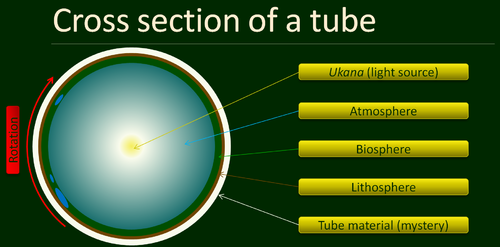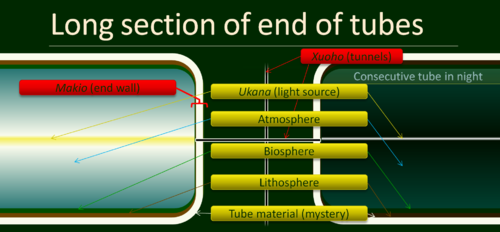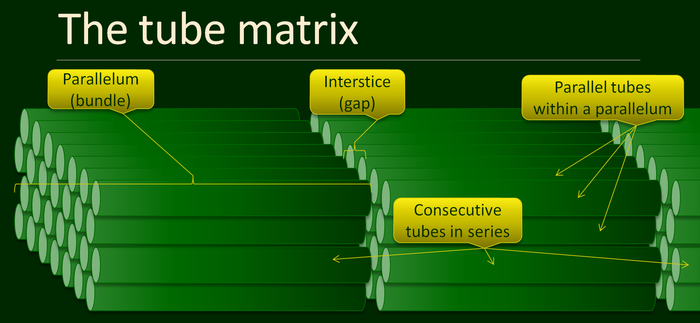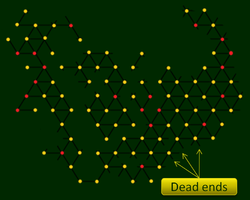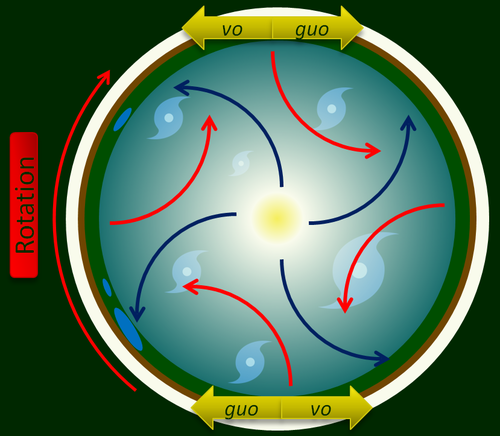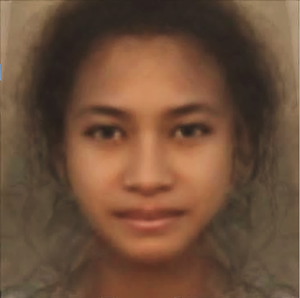Verse:Qu
This article is private. The author requests that you do not make changes to this project without approval. By all means, please help fix spelling, grammar and organisation problems, thank you. |
Qu (/uː/, also spelled Oo or U; Iliaqu: qu [ʔú]) is, as far as is known, an enormous artificial structure located somewhere in outer space.
All that is known for sure about Qu is its appearance from the inside. Its true nature and origin remain a mystery although several hypotheses have been put forward, virtually all of which require the existence of a highly advanced extraterrestrial society as constructors of the world.
The most convincing of these is probably the Ark Hypothesis, which posits Qu as just a part of an enormous habitat designed for the preservation and/or study of life on Earth and possibly other worlds.
Terminology
The word 'Qu', also spelled U or Oo in English, is a transcription of the Iliaqu word qu pronounced [ʔú] which means simply 'world'.
The people of Qu refer to those who mysteriously arrive in Qu as taia [tàjá], roughly ‘ghost’ or ‘apparition’, and the world from which they come, Earth, as utaia [ùtàjá], literally 'ghost world'.
As the known parts of Qu are only home to one main cultural and linguistic group, they have no traditional endonym to distinguish themselves from outsiders. With their relatively recent and scant knowledge of outsiders, the people of Qu have started creating endonyms. Their world is generally simply termed qu and their language is iliaqu ('language of Qu') where they had previously only used the word ilia ('language'). Utaia, Earth, is not regarded as part of their world and taia, Earthlings, are not always regarded as golu [ŋolú], 'ordinary people'. Thus golu may also be used as an endonym and some terrestrial authors use the transliterated word 'Ngolu' for both the language and the people, while others use the word 'Qu' or 'Oo' for both.
The word goqu [ŋòʔú], meaning 'Qu person', is, by all reports, gaining ground in Qu and so the world 'Iliaqu' will henceforth be used here to refer to the language and 'Goqu' for the people.
Evidence for Qu
For at least 100 years, in various parts of the world, people who had been missing, in some cases for more than fifty years, have reappeared, claiming to have lived in another place that is not Earth. Others have been found with, initially, no knowledge of any language spoken on Earth. In the past, regretably, some of these people ended up in psychiatric institutions as similarities between their stories were never discovered.
More recently, these accounts have been compared and analysed and found to be remarkably consistent. What is more, the fact that all of these people have some knowledge of the the same language, Iliaqu [ìʎàʔú], indicates that it is more than a collective illusion.
Travel between Earth and Qu
How people travel between Earth and Qu remains a deeply puzzling mystery. All who have travelled in either direction have experienced a state of amnesia surrounding the time of their travel. Many of those who had disappeared had done so whilst travelling alone in remote areas. In a few cases, the appearance or disappearance of Qu-travellers has coincided with sightings of UFOs and a frequently proposed hypothesis is that extra-terrestrials of the same civilisation that may have built Qu periodically ferry humans to and from the Earth in order to enrich the gene pool within Qu.
Structure of Qu
Vuqu: the tubes
Life in Qu is lived out on the hilly, largely rainforest-clad interior surfaces of enormous rotating tubes called vuqu. The rotation creates an artificial gravity pressing out against the inner surface, approximately equivalent to that felt on Earth. Several hundred tubes are believed to be known to the Goqu people and passage between them, though strenuous, is possible.
The dimensions of the tubes have not been accurately measured according to terrestrial measurements, but as far as can be ascertained, their diameter is roughly six kilometres and their length between 60 and 100 kilometres.
The material out of which the tubes are constructed is entirely unknown, however it presumed to have a tensile strength exceding that of all substances known to humankind. Each tube contains a lithosphere, a biosphere and an atmosphere, as seen in figure 1.
Although the vuqu are closed tubes, bright apparent daylight floods the interior in a day-night cycle as on Earth. From any one position, it appears as if a bright sun-like light source, which the Goqu call elo, moves each day through the centre of the tube from la 'east' to ta 'west'. The illusion of a glowing orb that travels the length of the tube during the day is, however, shattered by the fact that the portions of the tube that should be closest to this apparent singular light source are not more brightly lit. Instead, the entire tube is lit more or less uniformly with the exception of the eastern end during the morning and the western end during the late afternoon.
Attempting to triangulate this apparent sun from various points along a tube by simultaneously measuring the angle of the elo in the sky results in an apparent infinite distance, while triangulation from points around a tube indicate the light sources is in the centre of the tube.
The light of the elo is in fact emitted by the ukana or 'sun spoke', a thick bar running through the centre of each tube. This can be clearly seen when the ukana is shrouded in clouds which scatter the directional light. It then appears as a long, straight, bright line in the sky. The illusion of a single source of light is caused by the highly directional (non-diverging) light emitted uniformly from along its surface. As the angle at which the ukana emits light changes during the course of a day, shining westward in the morning, directly outward at midday and eastward in the evening. This causes the gradual change in position of elo, the apparent sun.
At night, dimmer lights can be seen from the ukana, and an apparent moon-cycle is simulated. This moon-like light is known as aila and although it does not display crescent and gibbous shapes, its timing and brightness changes throughout the month similarly to that of the Earth's moon.
Xuoho: tunnels between tubes
Travel between tubes is possible thanks to a network of tunnels called xuoho [ʃwòhó] that link the tubes with other tubes, as seen in figure 2. These tunnels connect the hubs of consecutive tubes and tunnels branching from nodes half way between consecutive tubes radiate out towards the hubs of parallel tubes.
To reach the opening into the tunnel, one must climb around 3 kilometres up the end wall of a tube, known as a makio [màkjó]. Most makio are near vertical, although many have comparatively easy paths up to the hub. With increasing altitude, the force of centrifugal gravity decreases, making the climb less and less strenuous as one makes progress. Despite the gradual decrease in gravity, the climb is perilous. The rotation of the tubes causes a strong vertical coriolis effect, causing whirlwinds looking like lazy horizontal tornadoes to stretch along the tube and sweep over the end walls. Many convenient climing paths are relatively sheltered in grooves in the end wall, and over the years, people have carved steps and handholds into often-climbed walls, but climbers in exposed positions, if caught by a whirlwind unawares, can easily by sucked off the wall and fall to their deaths.
Nearing the hub, the attachment of the ukana can be clearly seen. There is a stretch of ukana near each wall that does not emit light at all. Nevertheless, most climbs occur around dawn on the eastern walls, while the ukana beams its light away towards the west. Sunlight first hits the eastern wall at midday. With the hub in sight, the opening to the tunnel can usually be located by watching for bats or swiftlets which migrate between the tubes. The opening is usually reasonably wide, although some tubes have very tight holes to squeeze through.
At certain times of the day, the wind races through the tunnels. Consecutive tubes are apparently always out of phase in their day-night cycle and as one tube warms up and its air expands, the tunnels act like valves on a pressure cooker, allowing the air to rush into the neighbouring tube, where the cooling air is beginning to take up less space. Because of this wind and the lack of gravity, those who lose their grip in the tunnels may end up blown out away from the end wall, gradually begin to fall and end up thrown diagonally against the outside of the tube by the rotational forces.
Entering the tunnels, there is a smooth line in the rocks where the rotating tube attaches to the non-rotating tunnel. From this vantage point, one can observe the rotation of the tube, which takes about two minutes to make one revolution. The inside of these tunnels is described as being like a breezy, weightless cave. The air is filled with echolocating bats and swiftlets. It is not known if they breed in the tunnels or simply migrate through from one tube to the next, experiencing an eternal day or night and taking advantage of windblown insects on the way. Their droppings are mostly cleared by the winds, but the walls are coated with bioluminescent, filamentous fungi, which trap and feed on what they can.
When heading straight ahead to a consecutive tube, the path is generally short, only a few hundred metres long and fairly easy to navigate owing to the tell-tale breeze and thick layers of bioluminescent fungus on the walls giving off a dim blue-green glow. Travelling to a parallel tube is much more difficult. To get there, one must find the 'node' half way between the consecutive tubes. Six additional tunnels radiate away from a node. The closest parallel hubs are around seven kilometres away. In these long tunnels, there is less wind, less fungus and thus less light. Knowing which path to take to get to a particular tube is also challenging, as the rotation of the tubes shifts the apparent orientation of the six tunnels radiating away from the node, making it very difficult to know which tunnel leads where. Furthermore, after many kilometres of awkward weightless travel, a tunnel may turn out to blocked and be a dead end.
The tube matrix
Although the tubes have never been seen from the outside, the knowledge of the structure of the tunnels leads to the conclusion that the tubes are arranged in a vast matrix of both parallel and consecutive tubes as illustrated in the figure 3. at right. The number of parallel tubes in any one parallelum is not known, nor is the number of consecutive parallela, and many Goqu believe that this matrix is infinite in all directions.
Figure 4. shows a hypothetical map of access points to tubes to the west of the tunnel network within a particular interstice. Black lines represent known tunnels. Yellow dots represent nodes with access to their western tube. Red represents nodes with no access a tube to their west. While it is logically possible that there may be gaps in the matrix of tubes, there is no way that the absence of a tube could be proven and many instances where a gap was presumed have later been found to contain a tube to which no one knew the way before. Many tubes are inaccessible from one end but accessible from another. For example, the tube behind a red node on the map in figure 4. may be accessible from the other end and a similar map drawn for the interstice at its other end could have an entirely different layout. Some tubes may have an unscalable wall (makio) at one end. In others, climbing the makio is possible, but there is no apparent opening into the network of tunnels. The tunnels themselves are blocked in many places. In some cases, the only way to travel from one tube to one of its immediate parallel neighbours may be to travel through several consecutive tubes before shifting to a parallel tube and travelling all the way back through consecutive tubes. The Goqu summarise parallel tubes of this nature as ei mie kuaqa, 'close yet far' and new routes and new tubes are occasionally discovered, making it clear to all within Qu that their world is much larger than what they know of it.
Weather and climate
Due to the rotation of the tubes, there are strong horizontal Coriolis forces whose effects can be seen when observing weather patterns and when any object falls from a great height. Falling objects, including rain and cold masses of air, lack the rotational velocity of parts of the tube further from the centre. From the perspective of someone standing within the tube, falling objects appear to be drawn backwards relative to this movement as they fall. This backwards direction is called vo in Iliaqu and can be translated as 'south' as it is 90° to the right of the direction of dawn light.
Rising masses of warm air retain the momentum they received from the rotation of the outer parts of the tube as they enter higher (more inner) parts of the tube, causing their apparent path to curve 'forwards'. This forward direction is called guo in Iliaqu and can be translated as 'north' as it is 90° to the left of the dawn light.
The coreolis forces working on falling and rising masses of air have an interesting effect on the atmosphere within tubes, as seen in figure 5. Thermals rising from the ground do not give rise to puffy cumulus clouds but rather horizontal rolls of cloud which extend lengthways across the tube while rising. Falling rain likewise tends to spawn horizontal vortices which slowly move downwards (outwards) while interacting in complex ways with nearby updrafts.
Virtually all of the tubes of Qu have a warm, humid climate Most tubes have a pronounced wet season, in which masses of water are expelled from the ukana as mist, typically heralded by a dramatic light-show from the ukana in the late afternoon which seems to mimic the lightning display of a tropical thunderstorm. The 'lightning' display is, however, completely silent and somewhat more extravagant, with dramatic flashes and changes in direction of light, causing various parts of the tube to be brightly illuminated while others are in darkness, as though spotlights are cast on the ground. The mist ejected by the ukana billows and swirls in the near-weightlessness of the central atmosphere, trapped by the tight swirling of the coreolis effect. When the ukana is surrounded by dense cloud, fog or rain, its whole length is visible as a bar of light in the sky and the flashes of the 'lighting show' can look a little like a straight bolt of lightning through the sky. As ukana continues to expel mist, the atmosphere around it becomes overloaded. The mist swirls in tight eddies and collides, builds into larger and larger droplets which gradually whirl their way down in rolling, swirling cylinders of cloud that strike the surface of the tube as heavy downpours. Even in the ‘dry’ season, the constant high humidity creates natural showers and frequent fog and the ukana augments this natural water cycle with ejections of mist, which mostly occur during the night. Quite notable at night time are the billowing clouds that seem to erupt from the openings near the hub of the end walls of the tubes. These result from the warm breeze coming through the passageways from the neighbouring tubes in their daylight phase.
Geography
The inner surfaces of the majority of the known tubes of Qu are hilly and cloaked in dense tropical rainforest. Some tubes are dominated by water, either fresh or salty. Many of these water-dominated tubes have a number of islands and coral reefs abound.
Even among the mostly forested tubes, numerous rivers, streams and riverlets carve their way across the landscapes through deep ravines, over waterfalls and into lakes. There are believed to be outlets through which this lake water is recovered to appear in the ukana’s downpours.
Flora and Fauna
The species present in Qu are not from any one particular geographic realm on earth. To take birds as an example, the following kinds of birds can all be found in Qu:
- The Americas: hummingbirds, toucans, macaws, quetzals, tanagers, todies, cock-of-the-rock, manakins, hoatzin
- Africa: turacos, glossy starlings
- Asia: peafowl, broadbills, hornbills, pittas, paradise flycatchers
- Oceania: cockatoos, birds of paradise, bowerbirds, cassowaries
Endemic Species
Many species found in Qu do not appear to correspond exactly to a species found on Earth. Depending on the time since the introduction of various animals, there has doubtless been some level of evolution within Qu, and there are possibly some species in Qu which have become extinct on Earth without leaving any trace.
Notably absent are any animals larger than a human. The largest animals are cassowaries (probably the dwarf cassowary Casuarius bennetti or similar), babirusa and capybaras and the largest predators are harpy eagles and a medium sized cat which, from descriptions, is probably a variety of clouded leopard.
The alaila
One endemic species which is held in high esteem in Goqu culture is the alaila, the “blue cockatoo”. In form, it most closely resembles a large black cockatoo, however its feathers are a brilliant irridescent blue, shifting to green or purple in some lights. When the wings and tail are spread, brilliant red and/or yellow flashes become visible, and when seen flying from below, these appear to let sunlight through like a stained-glass window. It has a bare skin patch on the face which can be changed from yellow to red at will by flushing it with blood and can also be concealed with feathers. The tail is very long and square and, unusually, can be fanned into two halves, giving the appearance of a smaller set of wings or a whale’s tail flukes.
From all accounts, the alaila is very intelligent. It can recognise individual humans, solve complex problems and use and create tools, even going so far as to carry sharpened sticks while flying to defend themselves and other flock members from Eagle attacks. An eagle that kills or injures an alaila will often be followed and attacked by the flock and, as a consequence, eagles seldom bother alaila.
Aside from the standard cockatoo shrieking, the alaila makes a huge variety of calls and birds sitting quietly will appear to converse for hours, giving the impression that they have true language. They are gifted mimics and can learn to copy human words and use them in context. Its name, alaila means 'speaking bird' with good reason.
It is illegal to harm an alaila in Qu and no one but the Taqu (King) may keep them captive. Many of them, however, regularly visit those who feed them and voluntarily enter houses, coming and going as they please. They can even be taught not to defecate or chew on objects inside houses, and many individuals seem to enjoy socialising with humans. It is illegal to pluck feathers from an alaila, but naturally shed feathers are often used as personal adornment and some alaila will present their own shed feathers to people who feed them.
Goqu people
Among those who have arrived on Earth from Qu, the native Goqu have been the most studied. All have arrived on Earth with no knowledge of any terrestrial language. Researchers of Qu have made considerable efforts in petitioning for documentation and the right to movement for arrived Goqu in order to enable them to live near to one another and have the rights of a citizen in their countries of residence. Currently, the two main groups of identified Goqu on Earth are in Brazil and Germany and many terrestrial people who have lived in Qu have also moved to be closer to these centres.
Genetically, the Goqu do not appear to be closely related to terrestrial populations although they do share several genetic markers with Melanesian and Polynesian peoples as well as smaller numbers of indicators associated with peoples of India, Arabia and the horn of Africa. Physically, the Goqu are notable for their extreme sexual dimorphism, with the average height among seven studied Goqu men being 196cm and the average height for the four studied women being 159cm. The images below are blended composite photos of the four Goqu women and seven Goqu men who participated in the study.
Goqu Society
Goqu society is heavily stratified with six codified ranks.
- The state:
- 1. Taqu the emperor
- 2. taza senators
- 3. balu imperial guard
- The free:
- 4. muja initiated men
- 5. kali free women, children, unitiated men
- Possessions:
- 6. tuva slaves, pets
From muja and above, these ranks are implicational. All balu are muja, all taza are balu and so on. Generally, however, the word are not used in a nested way, with balu, for example, generally referring to balu who are not also taza. For the sake of clarity, "[rank] and above" will be used here where necessary.
Goqu society is extremely sexist, with ranks above kali being open only to men. Only muja and above are legally allowed to own anything (whether inanimate objects, pets or slaves) meaning that women and children cannot actually be regarded as the owners of anything. A great many activities are also proscribed for certain ranks.
The ranks are important for the concept of le ilutia [lé i̯lùt͡sá] 'speechcrime', which further complicates things for newcomers. Using the wrong pronominal forms with someone of a higher rank can have consequences, and in extreme cases, such as insubordination towards the emperor, can even result in 'le xagu' [lé ʃàŋú] – execution by being pushed face down in mud.
When two people of differing rank meet, by default, the higher ranked is dominant to the lower ranked and this will be marked in their speech with the choice of accessible and inaccessible pronominal forms. The higher is referred to in the inaccessible (I = nu, you = vu) whereas the lower ranked is referred to in the accessible (I = na, you = ua). This can change, such as when a friendship develops between ranks, but the change is always brought about by the higher ranked individual and may be revoked at any time. Non-adherence to these rules is speech crime and may be punished, with a couple of exceptions.
- (1) People may be offered a pass known as a tiava.
- (2) Kali must not necessarily be subordinate in speech to muja although a reason must be given.
- (3) The rules for tuva (slaves) require them to use inanimate forms when speaking to balu and above.
Tiava
The taqu (emperor) may offer a pass to anyone he wishes. Typically, taqu offer this to their family, meaning that the emperor's daughter, for example, although only kali, does not need to show subordination to higher ranks in speech. Tiava may be specified for a particular level. This may be expressed as follows:
tiava balu eni be.pass be.guardist DAT.1s.ICS I have a pass to the level of balu.
A tiava balu entitles the bearer to be dominant to all ranks below balu, equal with balu but subservient to taza and above. A tiava does not, however, bend the rules of what certain ranks are allowed or not allowed to do. For example, a tiava does not allow a woman to hunt. Bearers of tiava generally carry proof of this in the form of a band worn around the neck.
Kali and muja
While kali are technically subordinate to muja, unacquainted muja and kali typically start off using the inaccessible mode as unacquainted people do within their own rank. However, some muja may decide to lord it over a kali and insist on using the dominant mode, forcing the kali to use the subordinate mode. There is a way out of this. A kali may indicate their inaccessibility to their muja interlocutor by mentioning a muja (or above) to whom they are accessible. For married women, this is generally her husband. If a woman is not married, she may invoke a brother or a male friend. The invokee must be someone who is accessible to the kali and if she can somehow leave a hint that he is large or important, all the better. Children usually invoke their father or a house uncle. If someone has no one to evoke or, in protest, refuses to evoke anyone known to them, the goddess Niniva and the god Uoqu are often invoked. This may be somewhat tongue in cheek.
The muja almost always backs down upon this invocation and uses the inaccessible mode, but occasionally he may demand to have words in person with the person (or deity) who has been invoked. This can cause a lot of friction in the community.
Tuva
Tuva (slaves) are the legal property of a person and as ownership is only recognised for muja and above, this means all tuva are owned by men. Since it is not right to touch somebody else's property without asking, no one may touch a slave without the permission of his or her owner. Linguistically, however, slaves must use the subordinate mode but everyone knows not to actually touch someone else's slave.
When speaking to a balu or above, the accessible nominals to refer to oneself are apparently not low enough for a tuva. A slave must refer to him- or herself in the inanimate gender and to do this, the third person is used. In the beginning of the conversation, the specific indefinite form zu (NOM.3s.INAN.SPEC) is used, later switching to the definite xu (NOM.3s.INAN.DEF). Because this may be confused with the meanings "something" and "it", zu and xu, when referring to slaves in the first and second person, are generally only used as articles (with a following verbal which hangs in a kind of underlying relative clause) rather than on their own as pronouns. There are a range of different verbal constructions used, with the tuva taking the lead from the balu. Some examples are xu tuva ('the thing which is a slave'), xu tuvu ('the thing which is dirt'), xu buji ('the bug'), xu iti ('the thing which is small') ('the ugly thing').
The first and second person distinction can still be maintained with xu ila ('the thing which speaks' = 'I') and xu no ila ('the thing which is spoken to' = 'you').
A tiava kali may be bestowed upon a tuva by his or her owner if the owner is balu or above. This simply means that, linguistically, the tuva may behave as a kali. This is fairly rare and generally only afforded to favoured slaves and concubines.
Food
The foods eaten by the Goqu consist mainly of cultivated plants and hunted food. Agriculture is mostly limited to the keeping of small plantations and animals are mainly not kept for food.
Food crops
Many tropical food crops are present in Qu such as:
- avocado
- banana
- breadfruit
- cassava
- coconut
- dragonfruit
- guava
- jackfruit
- lychee
- mango
- papaya
- passionfruit
- pigeon peas
- pineapple
- starfruit
- sweet potato
- taro
- yam
In addition to the above-listed crops, there is also the leua, which appears to be endemic to Qu.
Meat
Commonly hunted meats in Qu include:
Mammals:
- babirusa
- capybara
- elephant shrew
- gibbon
- possum
- rat
- tree kangaroo
Birds:
- cassowary
- duck
- pheasants (including peafowl)
- tinamou
- miscellaneous small birds
Other vertebrates
- fish
- snake
- lizard
- frog
Invertebrates
- beetle grubs
- shellfish

